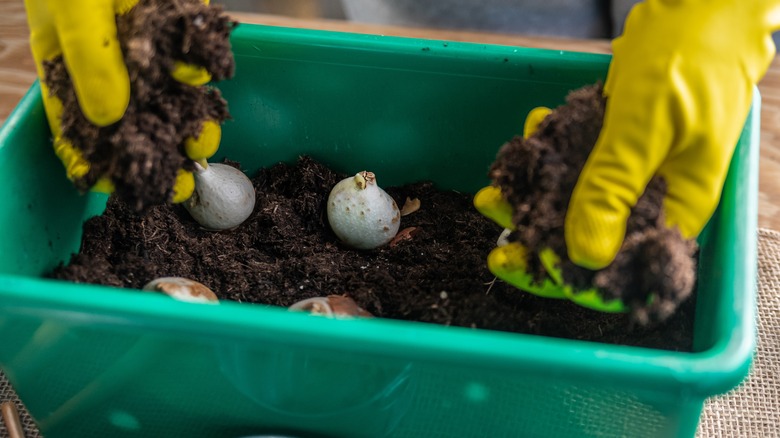December Is Not Too Late To Get This Spring-Blooming Flower Planted
As the weather turns colder, you may start dreaming of spring and making plans to ensure your garden is completely ready when it arrives. Preparing your garden for winter doesn't involve only composting dead plants or mulching your perennials. Doing some planting as winter starts is another way to ensure beautiful spring blooms. As long as the ground isn't frozen, you should be able to plant certain flower bulbs and seeds safely. One of those flowers is the tulip (Tulipa).
When learning what you need to know before planting tulips, one of the key pieces of information is when you should plant them. Put them in the soil as early as possible after you get them. As long as the ground outdoors isn't frozen in your region in December, the bulbs should successfully grow the following spring. Tulips are cold-hardy, and once planted, they'll go dormant during cold weather until early spring. Tulips will begin emerging from the soil anytime from February to May, depending on where you live.
The reason you shouldn't wait to plant tulip bulbs is that bulbs differ from seeds. The bulb, which grows from a seed, contains all the plant's primary systems, including roots and stems. A seed, meanwhile, doesn't have any of the structures of an adult plant. When placed in long-term storage, a seed is better able to survive without water and under difficult environmental conditions. Bulbs likely won't remain viable as long as seeds when stored outside of the soil.
Steps to follow when planting tulips in December
One of the mistakes people may make when growing tulips in the garden is planting the bulbs too early. The best time to plant them is before the ground freezes completely, but after the first frost. Planting them too early (before the first frost) could lead to a fungal disease called tulip fire, which is caused by the fungus Botrytis tulipae. You won't notice the problem until the tulip emerges in the spring, resulting in brown spots on leaves, twisted leaves, and rapid rot on the flower petals.
To plant the bulbs, place them at a depth three or four times deeper than the maximum diameter of the bulb, which is often 6 to 8 inches deep. Once they're in the ground, place a layer of organic material several inches deep over them. This material can include straw, pine needles, or downed leaves. The organic materials help the soil maintain a more consistent temperature. Some people choose to place netting over the soil before adding the organic material. Certain animals may dig up the tulip bulbs and eat them during winter, but the net should protect the bulbs.
You can plant the bulbs in pots if the ground is frozen
If the ground is frozen before December in your region and it's too late to put the bulbs in your garden, you can put them in pots instead, ensuring they're ready to plant in the garden the following year. Use a large container that's at least 24 inches in diameter if the pots will be outside all winter, as you'll need a large volume of potting soil mix to prevent the bulbs from freezing. You can also place them in a smaller container, closer to 18 inches in diameter, in a location that remains between 38 and 50 degrees Fahrenheit.
When planted in the container, the bulbs should be six to eight inches deep, just as with in-ground planting. Always use a high-quality potting mix, as tulip bulbs require well-draining soil. Once the weather begins to warm, you can move the pots outdoors and let the tulips continue to grow in the containers, or you can transplant them to your garden. The best time to transplant them is after they've flowered. Transplanting them too early could damage the root system and cause them to die.


